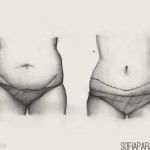Liposuction and liposculpture are not procedures aiming at weight loss. They involve the removal of body fat with a hollow cannula and suction. The fat is softened first by injection of fluid or through an ultrasonic machine. It is ideally suited to patients that have a stable body weight and are not obese. Localized fat is ideally suited for treatment with this method. Liposculpture describes the method of using liposuction to contour the body.
The surgery
Large areas are done under a general anaesthetic while a small area can be done under local anaesthetic and sedation. It can in some cases be done without staying overnight in the hospital. A series of tiny incisions is made in the skin to insert the cannulas in order to address the appropriate areas. It is necessary post-surgery to wear a compression garment (bought by you according your size), to assist skin shrinkage. The garment has to be worn for 15 days continuously (except when you take a shower) and for 30 days more at least 12-18hs daily. Pain is mild and can be controlled by oral medication.
Complications
It may be necessary if huge amounts are removed to have a blood transfusion. Skin irregularity may result after removal of excess superficial fat. Asymmetry of the areas treated may occur. Infection of the wounds is a theoretical possibility. If ultrasonic liposuction is used the viability of the skin may be compromised especially around the insertion area of the cannula.
After the surgery
The area treated will be swollen and bruised. It can take 2-3 weeks for the bruising to disappear. The incision lines are covered and should be kept clean and dry. It is better to avoid strenuous physical exercise for 3-4 weeks. The sutures are removed 10 to 12 days later. The same fat cells cannot re-grow after the removal but if a lot of weight is gained fat cells may form again in the same area.
Transplanting fat from one part of the body to augment the soft tissues in another part has been done for a long time in plastic surgery. However recently a technique has been described to transfer the fat in a more careful way (liposculpture) so that a larger percentage of the fat will survive.
About 60% of the injected fat survives and therefore there might be a need for a second session of lipotransfer in case that the first result isn’t satisfactory. It can be used for breast augmentation with specific indications, lip enhancement, nose to mouth lines (nasolabial folds), or any other area suffering from lack of soft tissue.
Lipotransfer also helps in cases of facial lipodystrophy as in the case of scleroderma, AIDS, Parry-Romberg syndrome etc.
The surgery
Depending on the area involved it can be done under sedation and local anaesthesia or under general anaesthesia. You do not have to stay in the hospital. Fat is taken from an area like your tummy or thighs through two or three small incisions. It is then injected in a multi-layer technique to improve contour. Small incisions have to be made once again to inject the fat in the appropriate area. A certain amount of overcorrecting will be necessary as only around 60% of the fat survive. A small dressing will cover the incision lines.
Complications
Depending on fat survival you may need to repeat the procedure (especially in the case of breast augmentation). The small scars from the incisions normally fade after a time and blend in with the rest of the skin. Due to the multi-layer technique lumpiness is not common but may occur. Swelling and bruising can last from a few days to 10 days depending on the area. To reduce the risk of infection you will be given a suitable antibiotic.
After the surgery
Fat surviving at three months can be considered permanent. The sutures will be removed after 7 days. Depending on the area involved and the amount of swelling and bruising you may wish to avoid social contact for the first 5-7 days.

